Justin Mitchell has been working in visual effects for over 24 years. He joined Scanline VFX in 2008. His filmography includes various shows such as Battleship, Tomb Raider, Cosmos: Possible Worlds and The Nevers.
What is your background?
I started in the industry as 3D Generalist in television. Over the years, I have worn many hats and pride myself on having a diverse skill set. That said, when I started at Scanline, I was an FX TD. As we grew, I transitioned into a CG Supervisor and eventually a VFX Supervisor.
How did you and Scanline VFX get involved in this series?
Our involvement on this season was partially due to the great work done by our Munich studio on Season 3. They had created and destroyed the Russian Rift Chamber for Episode 8.
How did it feel to be part of this iconic series?
I was thrilled to be involved. I am a big fan of the show. I have a lot of fond memories of the 80s and love that the Duffer Brothers created the magical blend of Spielberg and King that defines Stranger Things.
How was the collaboration with the Duffer Brothers and the VFX Supervisors?
I didn’t work with the Duffer Brothers directly. There were so many VFX shots in this season that the production had three VFX Supervisors on their end. One of the supervisors, Michael Maher, is also a concept artist on the show so he was invaluable in clarifying the visual language sought by the filmmakers. Jabbar Raisani and Marion Spates both bring years of experience to the project and were focused on the last few episodes which contained the majority of our work. We’d get shots to certain level and then the VFX Supervisors would show them to the Duffers to make sure we were all on the same page. It’s definitely a team effort.
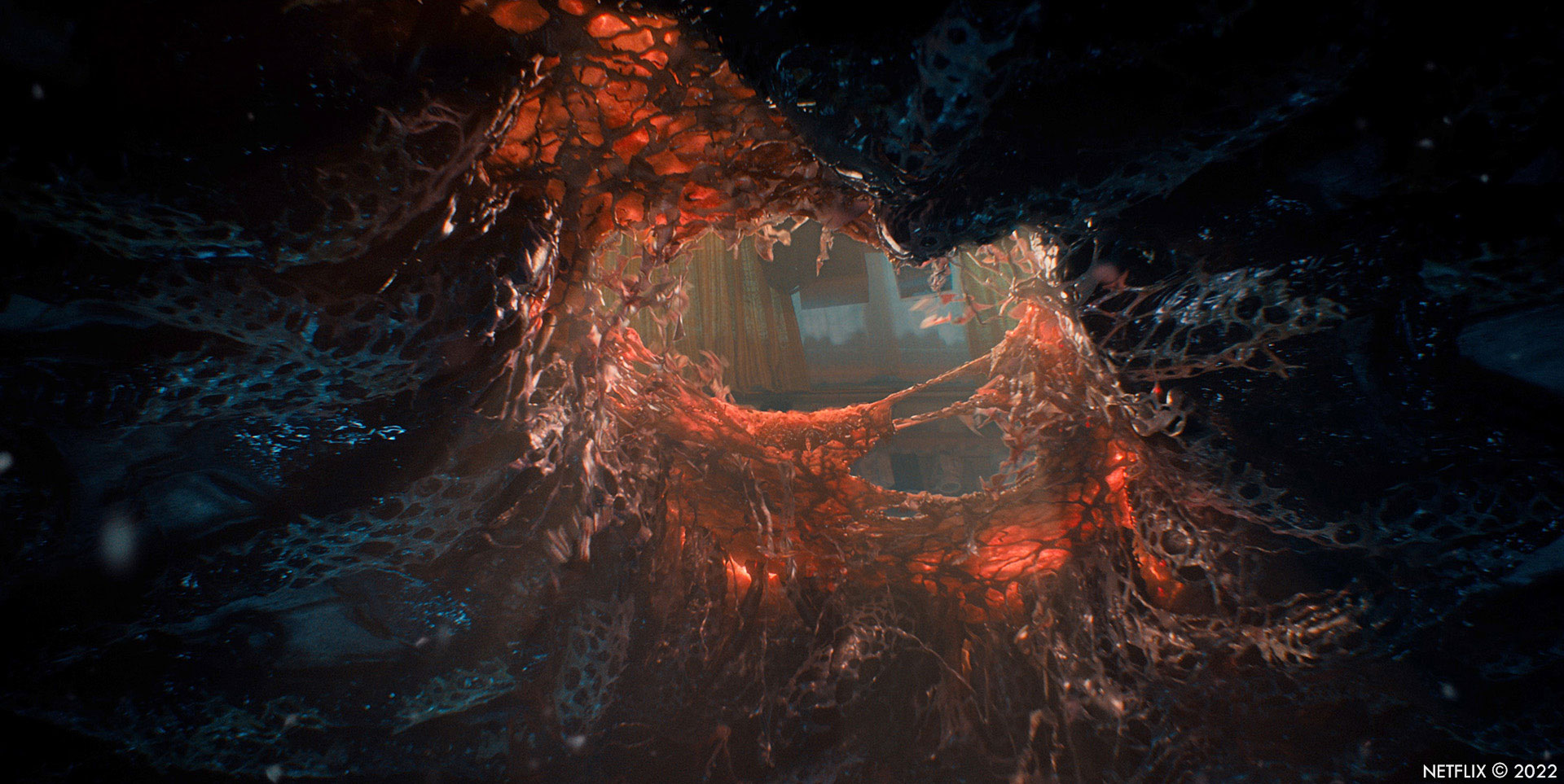
What were their expectations and approach about the visual effects?
For more complex shots we block them out in stages. For example, the rifts started as simple shapes animated in Nuke over the top of the plates to get the action right. From there, we did rough versions of any animation and FX to block key moments before starting to layer in more complexity.
How did you organize the work with your VFX Producer?
Scheduling is key when dealing multi-disciplinary VFX work. Without proper planning it’s very easy for a show to go “off the rails,” regardless of size. Early on we spend time to identify what departments will be involved in each shot and calculate the man-days per task. We then select some tentpole shots which will be prioritized for development. We schedule backwards from deliveries through the various department dependencies and try to spread out the work based on team, with the goal to final some shots as we go. In practice, the plan evolves but it’s a starting point.
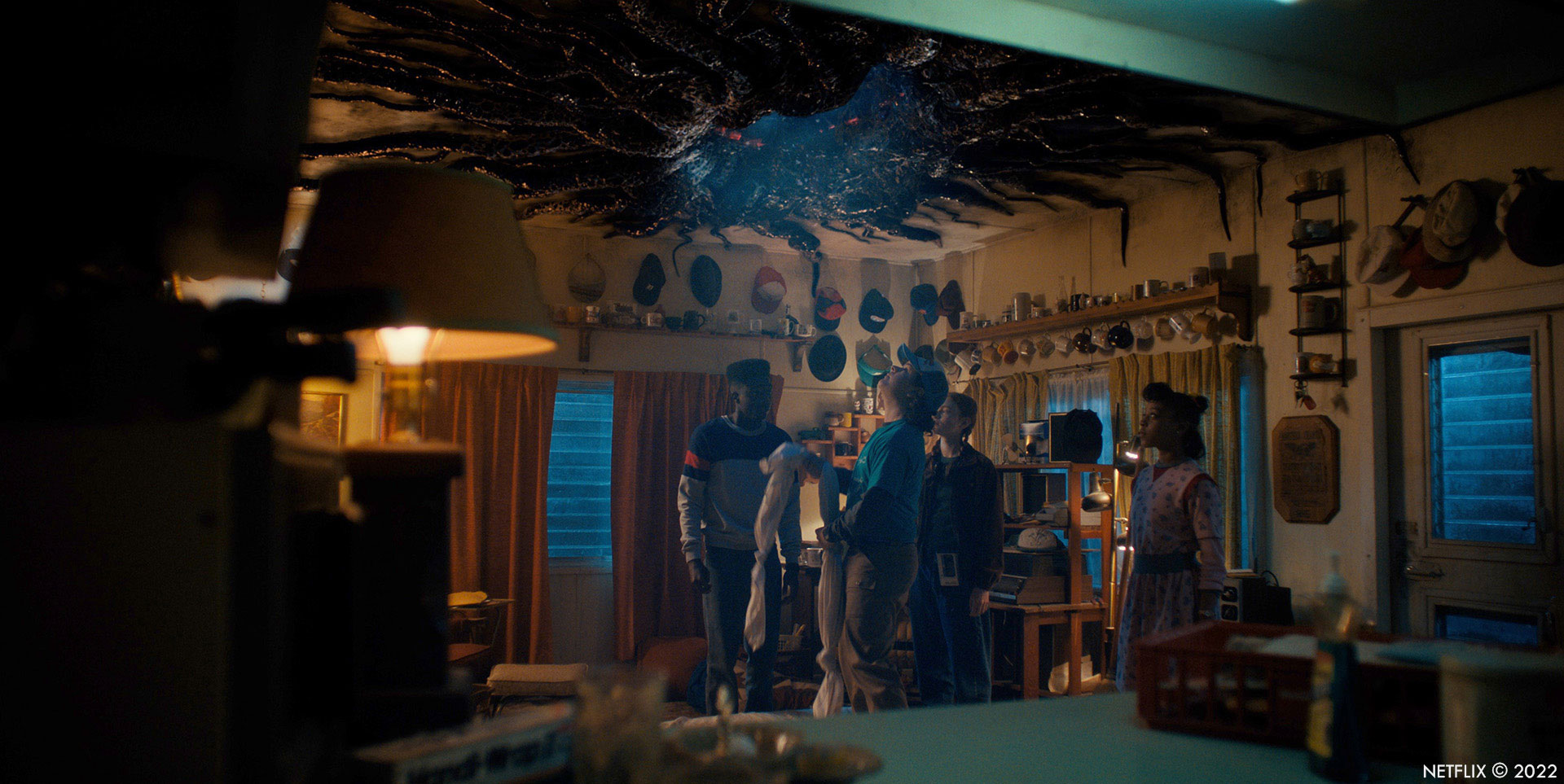
How was split the work between the Scanline VFX offices?
Most of the work was done in North America between our Los Angeles, Vancouver and Montreal studios.
What are the sequences made by Scanline VFX?
Scanline contributed 220 shots spread over 7 episodes, with the lion’s share of our work occurring in Volume 2. For Episode 8, we see Eleven bring down a helicopter outside the Silo Lab which involved us animating a CG helicopter as it spirals out of the sky, as well as the resulting crash aftermath. In Episode 9, we filled the Creel House with animated vines that grab some of the children as they pursue Vecna, and created the climatic event of four rifts tearing across different terrains, destroying everything in their path, before they collide in the centre of downtown Hawkins.
Our work on Volume 1 began in Episode 1 inside the Rainbow Room after Eleven has gone on a rampage. This sequence called for practical effects augmentation such as adding broken limbs and blood, as well as set extension work such as adding cracks to walls to enhance certain impact zones. Episode 2 saw us revisit the work we did on Season 3, as we flashback to Hopper in the Rift Chamber as the Russian gun starts to explode.
Episode 7 saw us turn One to ash during his fight with Eleven, leaving a slithery rift in his wake. Additionally, we augmented the rift on the ceiling of Eddie’s trailer which the children use to escape The Upside Down.
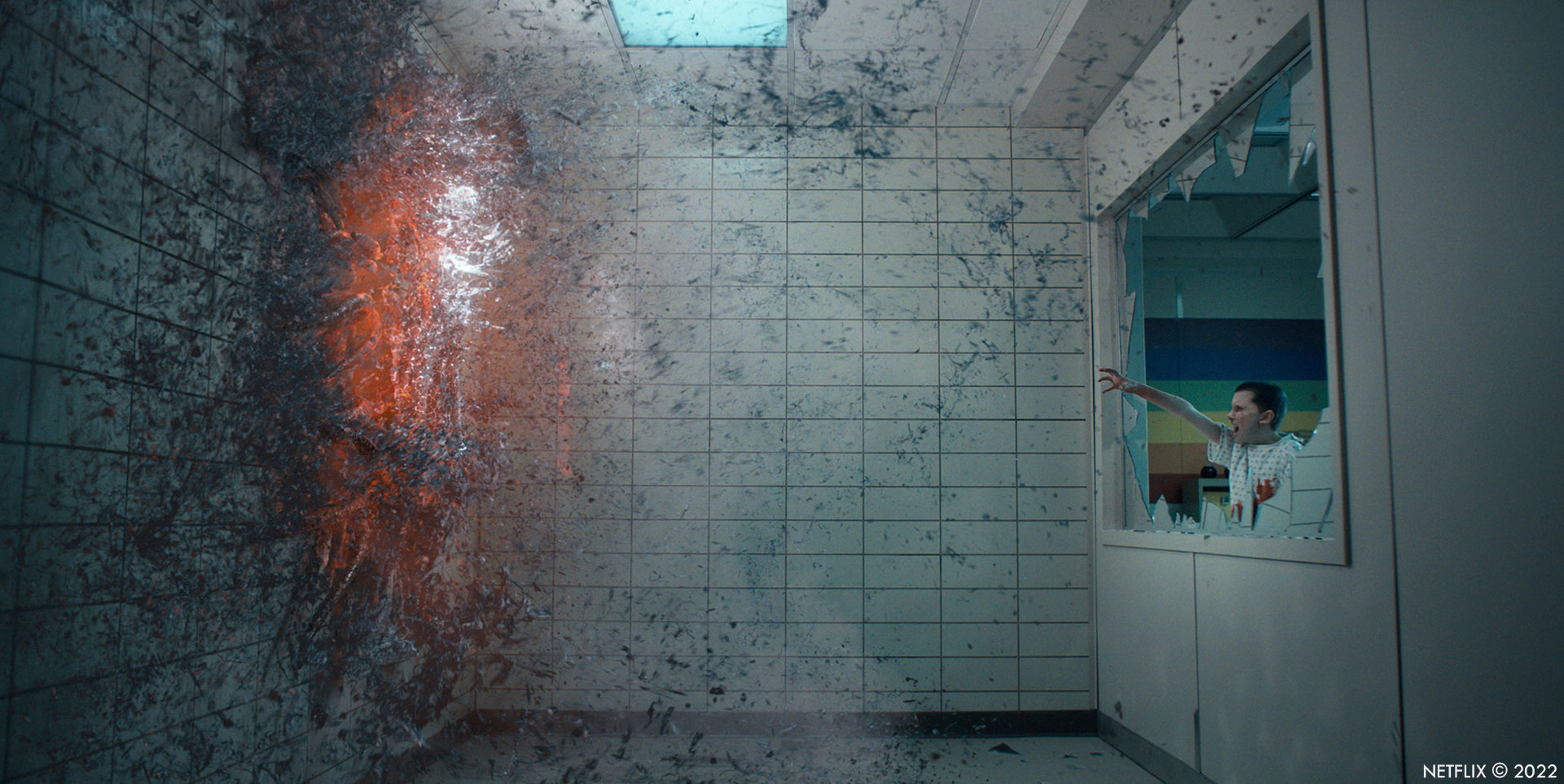
How did you recreate the Russian Rift Chamber from the Season 3?
Our Munich studio did the work on Season 3 so we started with that environment and augmented it to work with the new photography. We largely reinvented the gun explosion, favouring a more fiery look over the electrical nature of Season 3. It just felt more threatening and the Duffer Brothers preferred that aesthetic.
Can you elaborate about the design and creation of the impressive sequence of One’s body dissipating?
We created a digital replica of the observation room where One is pinned by Eleven and also a digital double of One. The 3D model of One was match-moved to the performance of Peter Ballard who was shot in a wire rig on set. The FX work was inspired by Eleven killing the Demogorgon in Season One. The simulation was done in Houdini whereby we solved an air field for the room using an invisible force pushing from Eleven’s hand. The end result was a combination of multiple cloth, particle and dust simulations moving through that field. Those were deep composited in Nuke where we also added interactive lighting provided from CG renders, as well as animated textures tracked to Peter’s body using smart vectors.
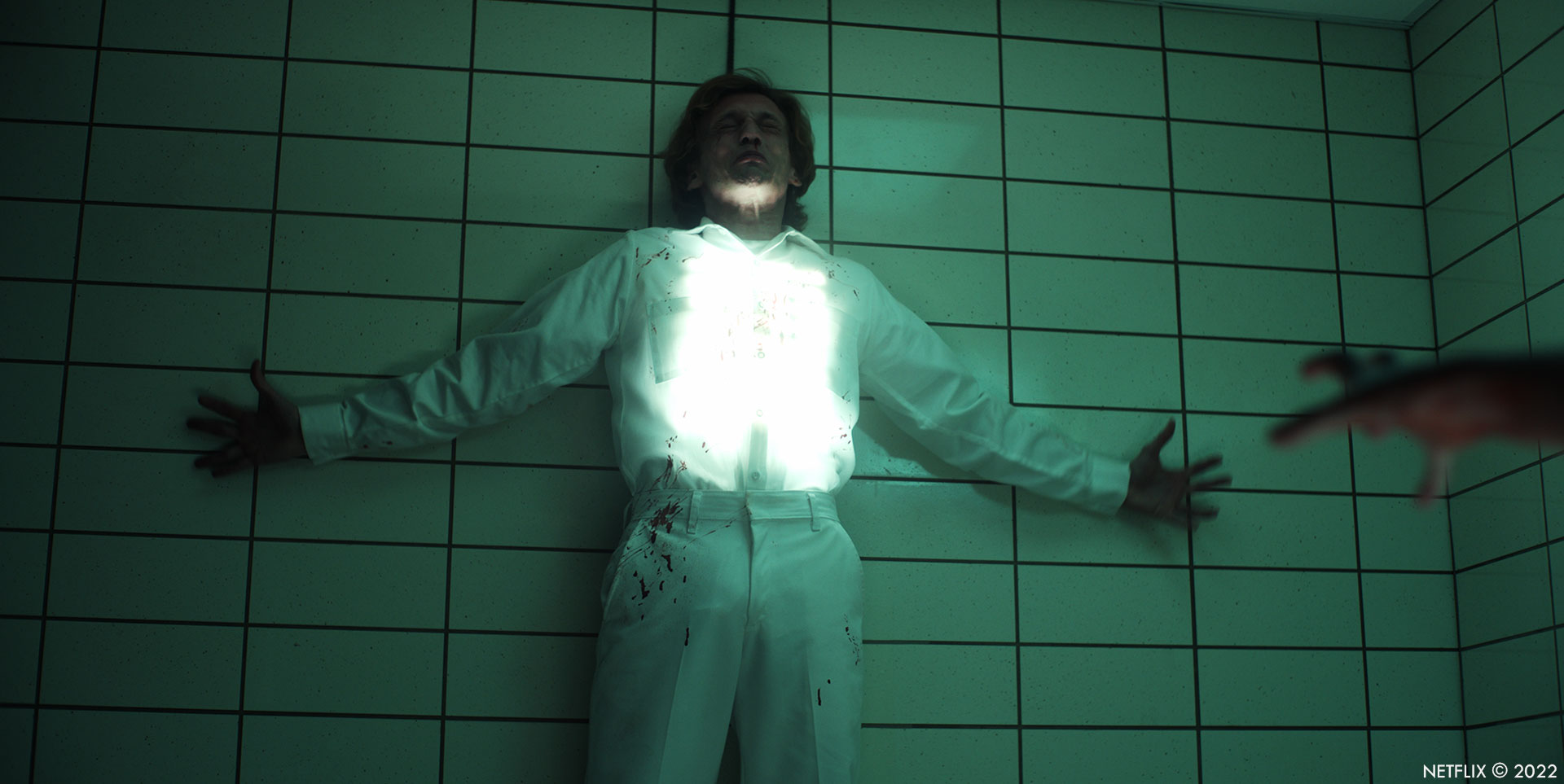
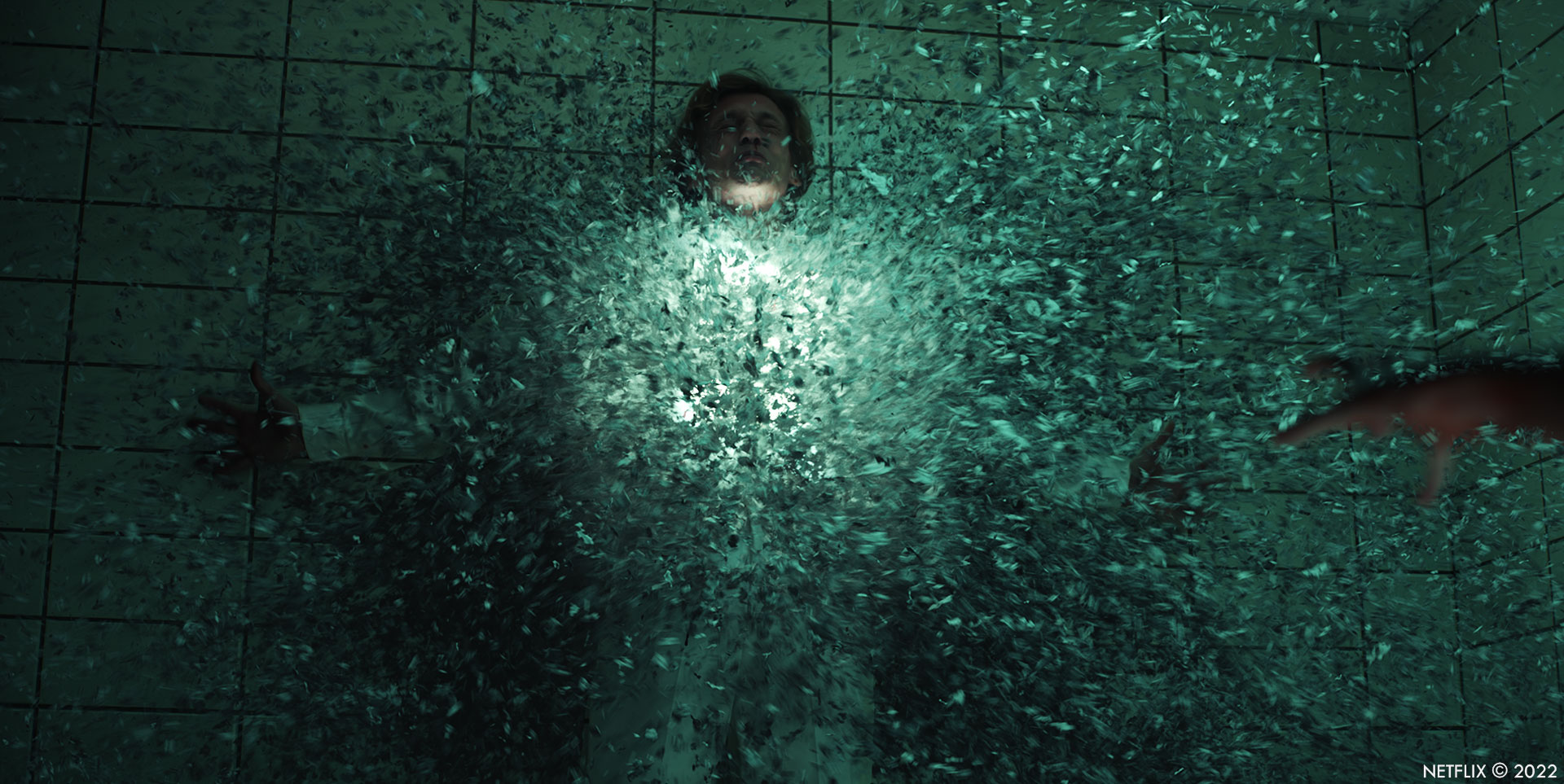
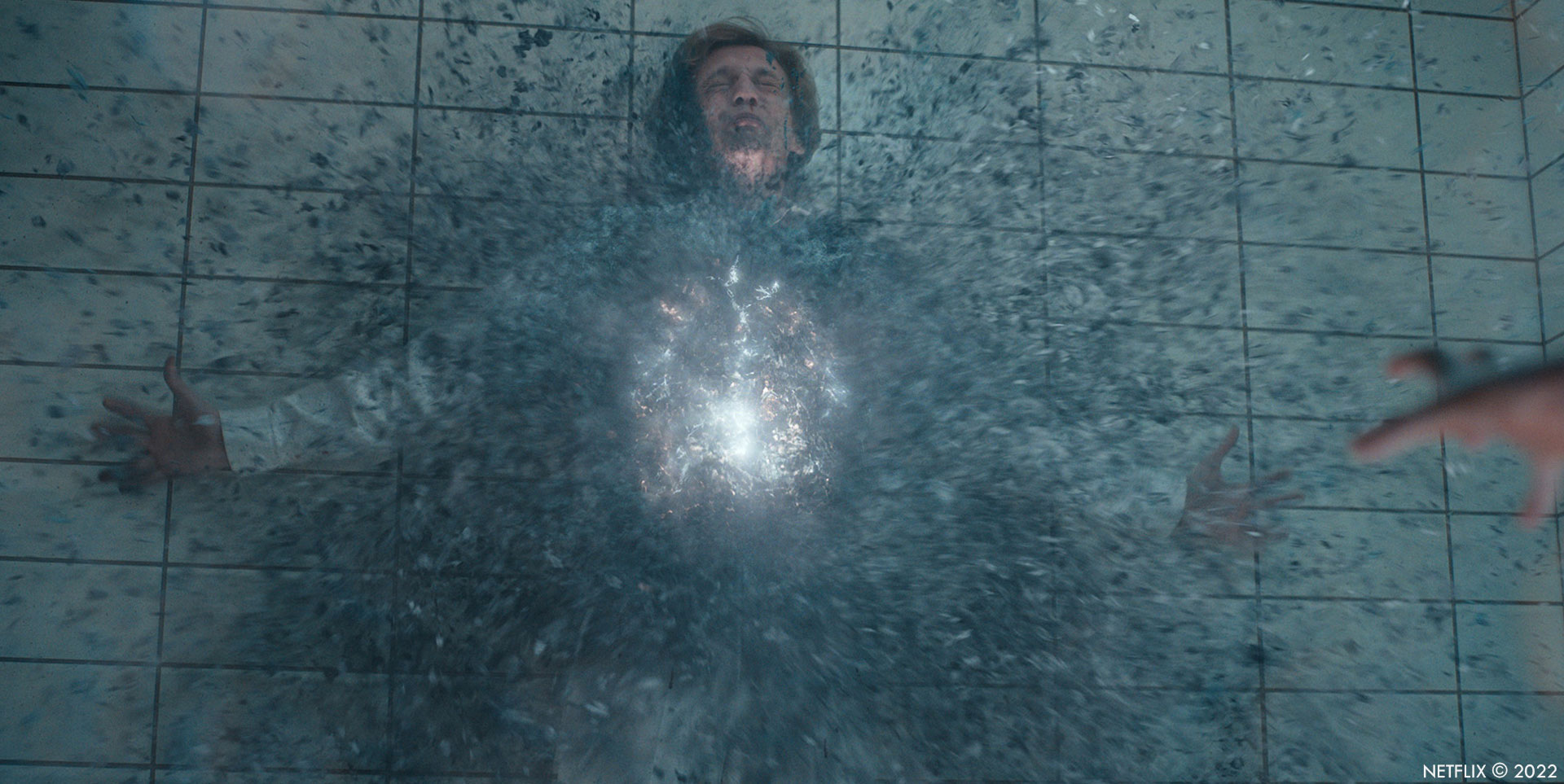
How did you create the various set extensions?
Environments that appeared in multiple shots, or shots that contained a lot of parallax, were created as full 3D assets. The Creel House and downtown Hawkins are examples of this. Other sequences such as the massacre in the lab relied on a lot of digital matte painting and in other cases, it was a combination of both.
Can you tell us more about the rift?
So many rifts! The rifts are gates between our world and the Upside Down. This season we created rifts of all shapes and sizes and it was challenging to find a look that worked in all contexts. We settled on a formula of 5 elements: RBD simulations, fleshy mould that spread from the sides of the rifts, vines that slithered out from below, an organic membrane that spanned the gap and red volumetric lighting coming from the Upside Down.
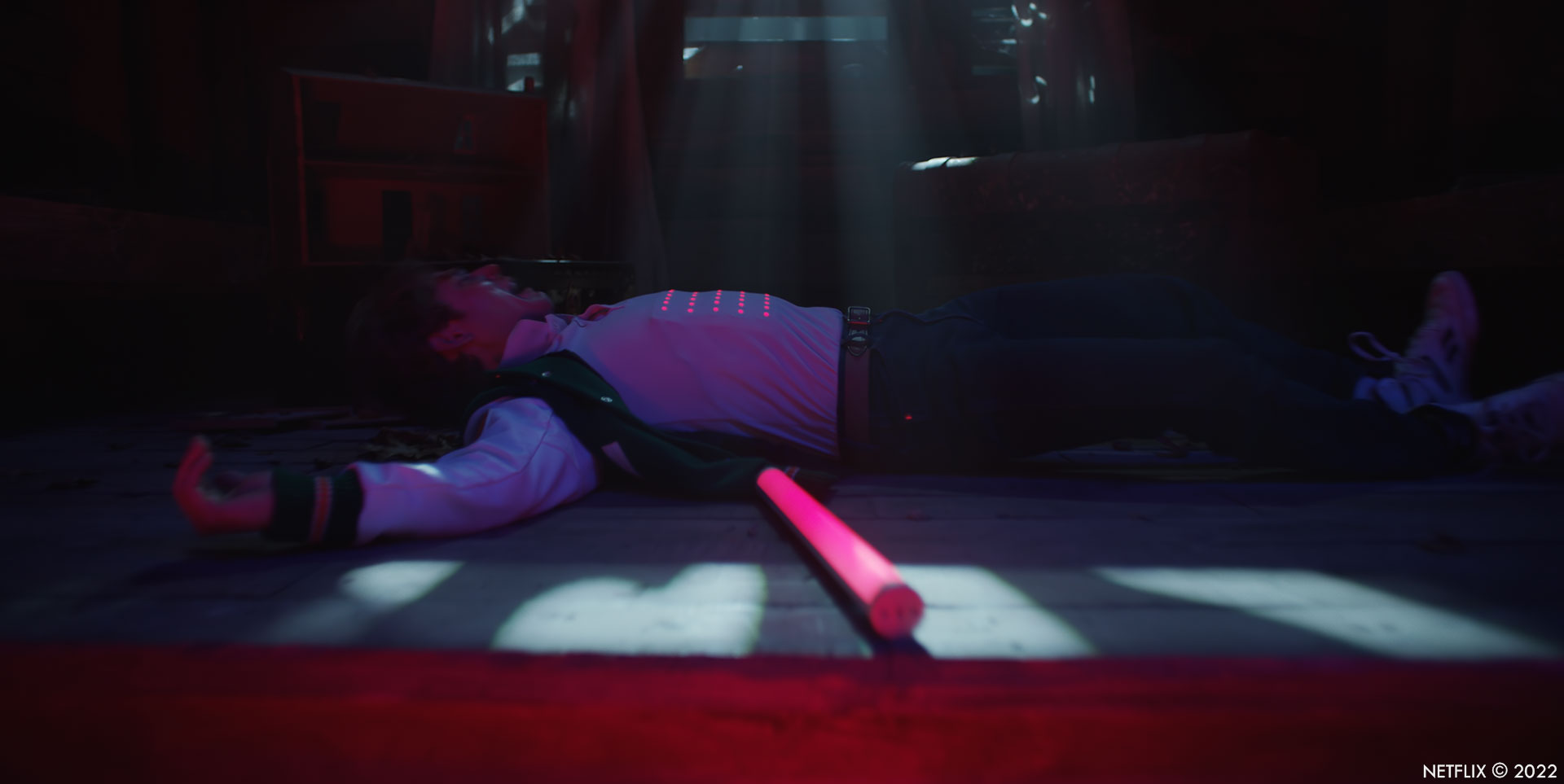
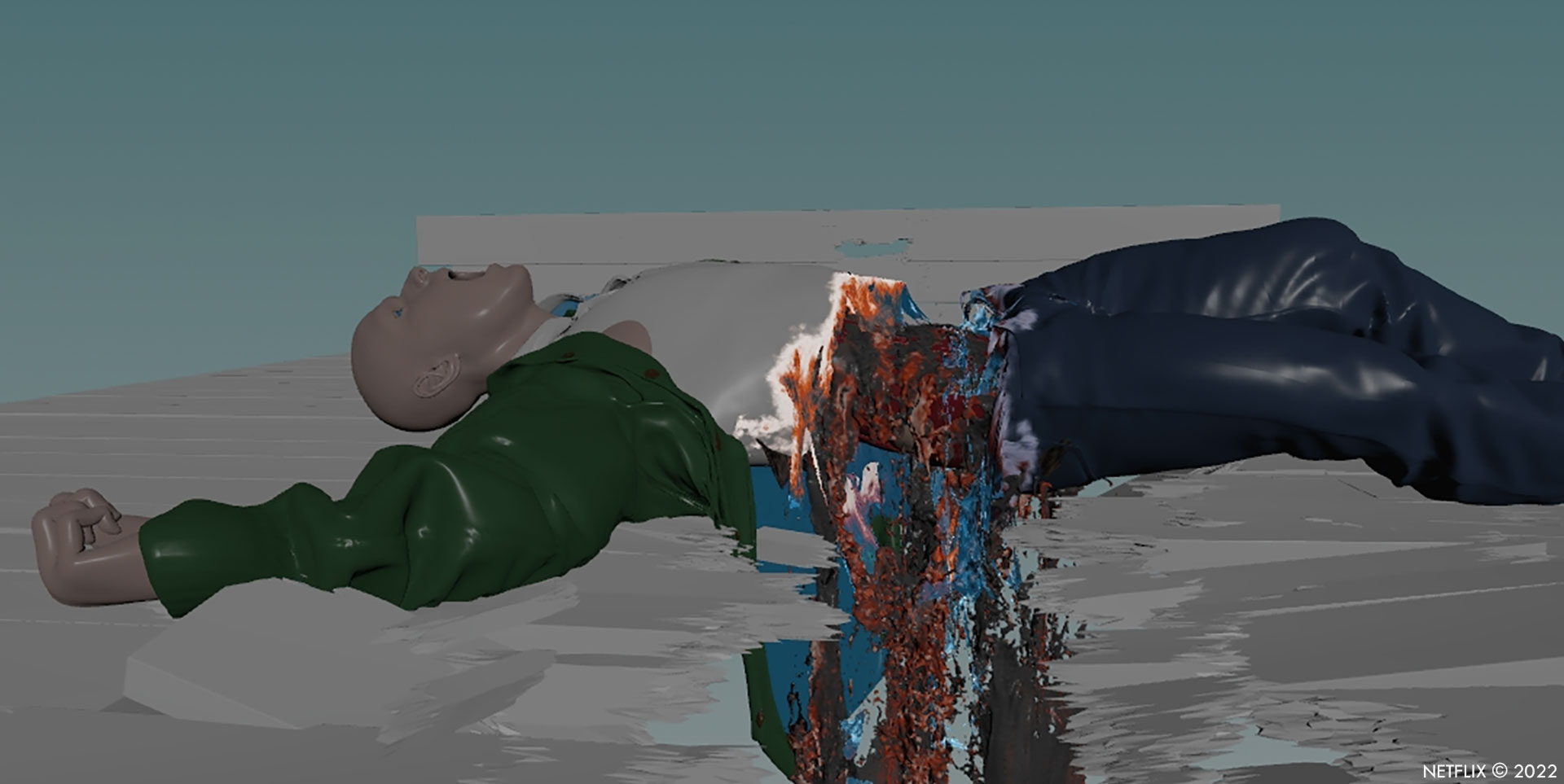
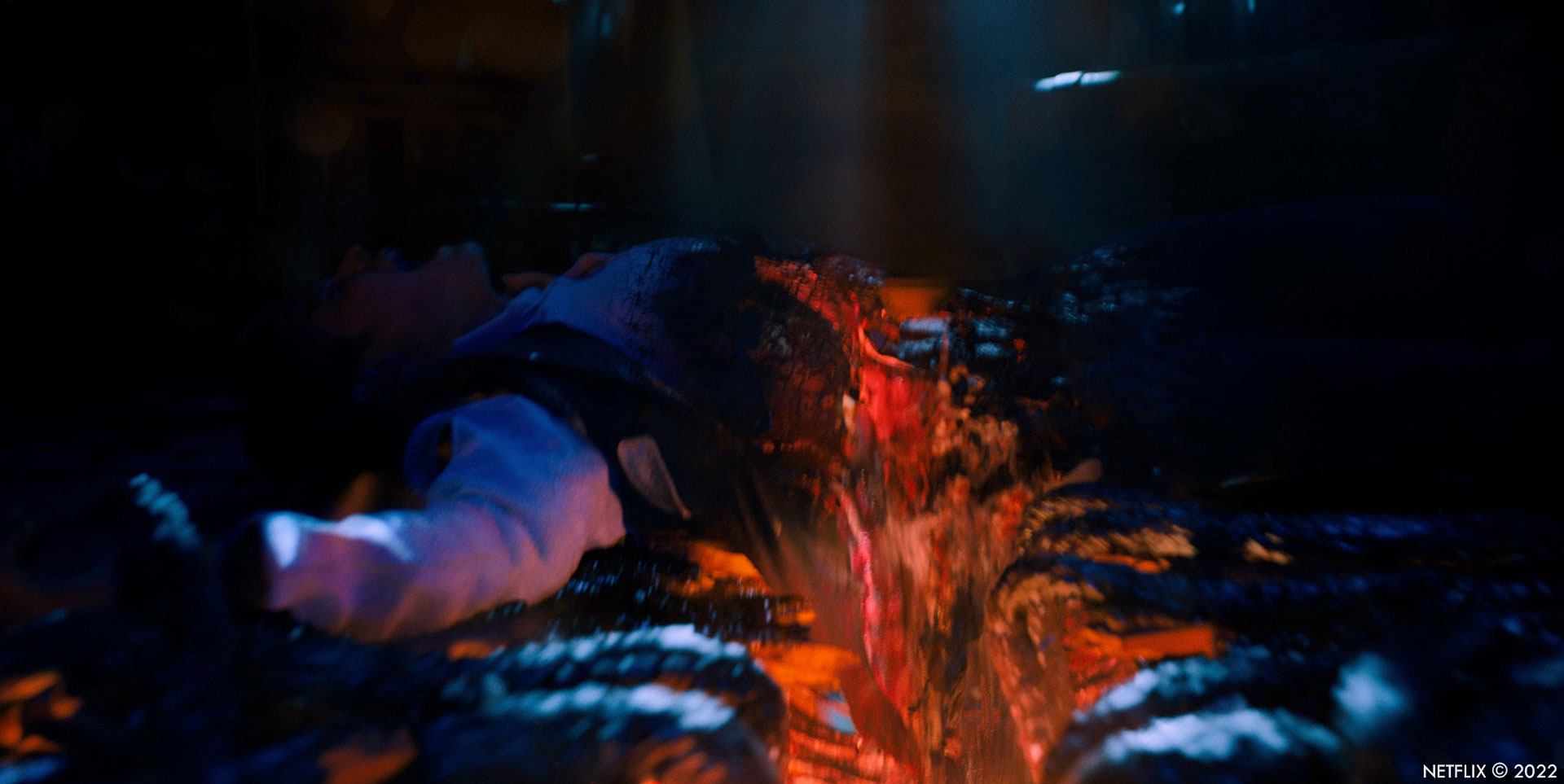
How did you animate the rifts in the Creel House and on Jason’s body?
It was a combination of rigid body, cloth and fluid simulations. Houdini and tyFlow were both used. The timing was defined by simple animated shapes during the layout phase.
What was the most complicated rift animation and why?
Probably the wide shot entering downtown Hawkins due to the fact it was entirely CG, there were many types of destruction and it was a long shot!
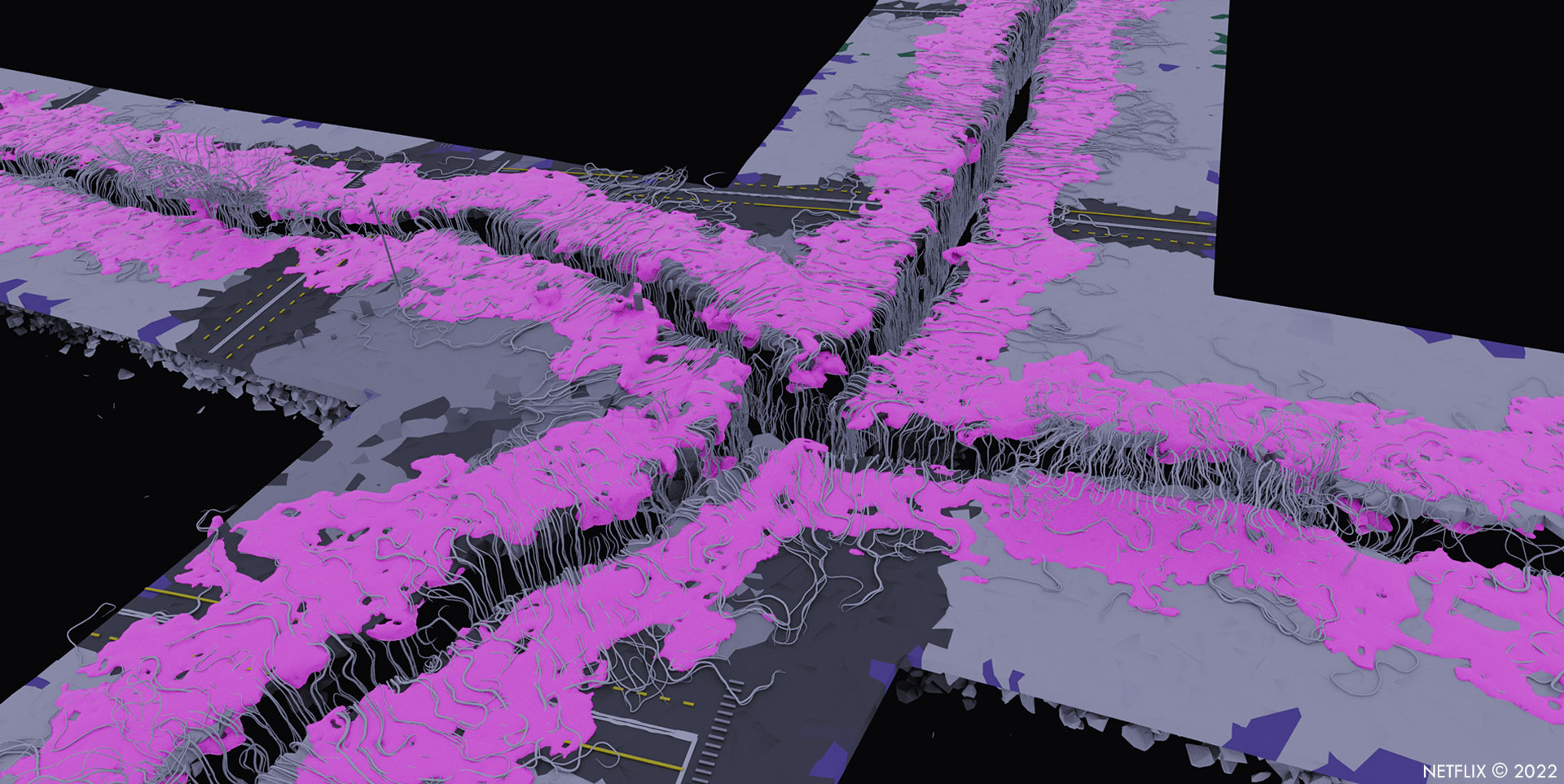
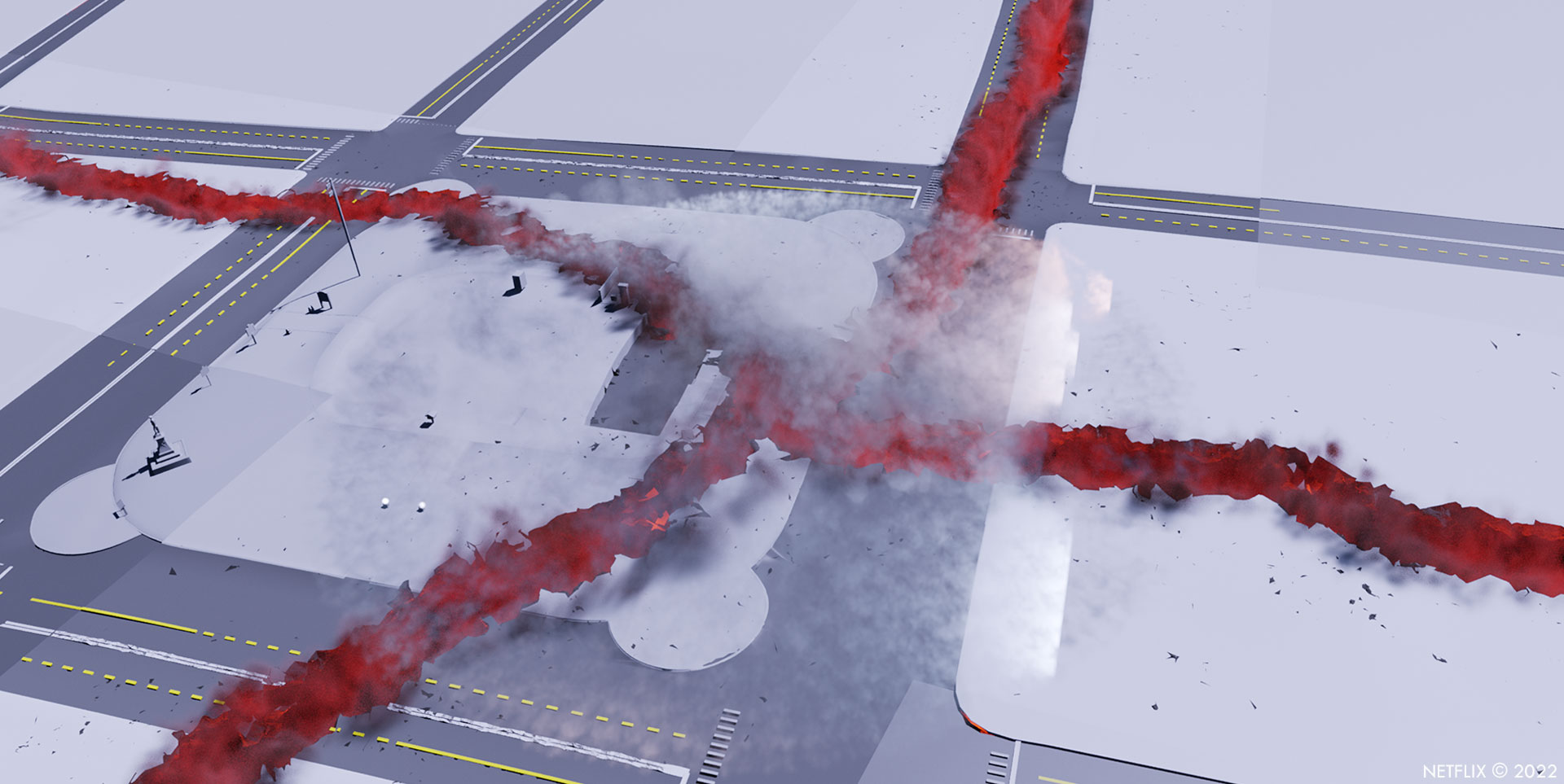
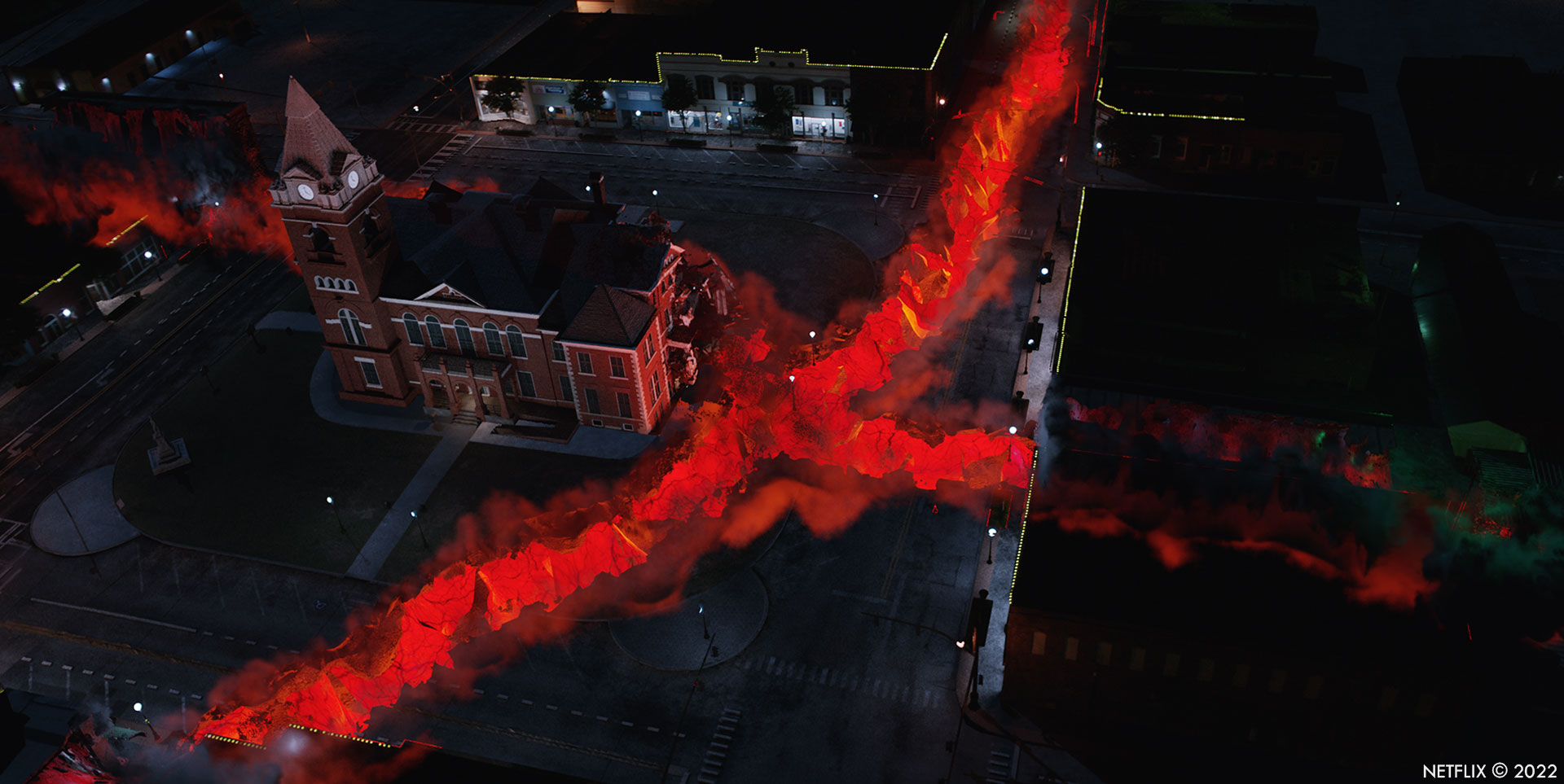
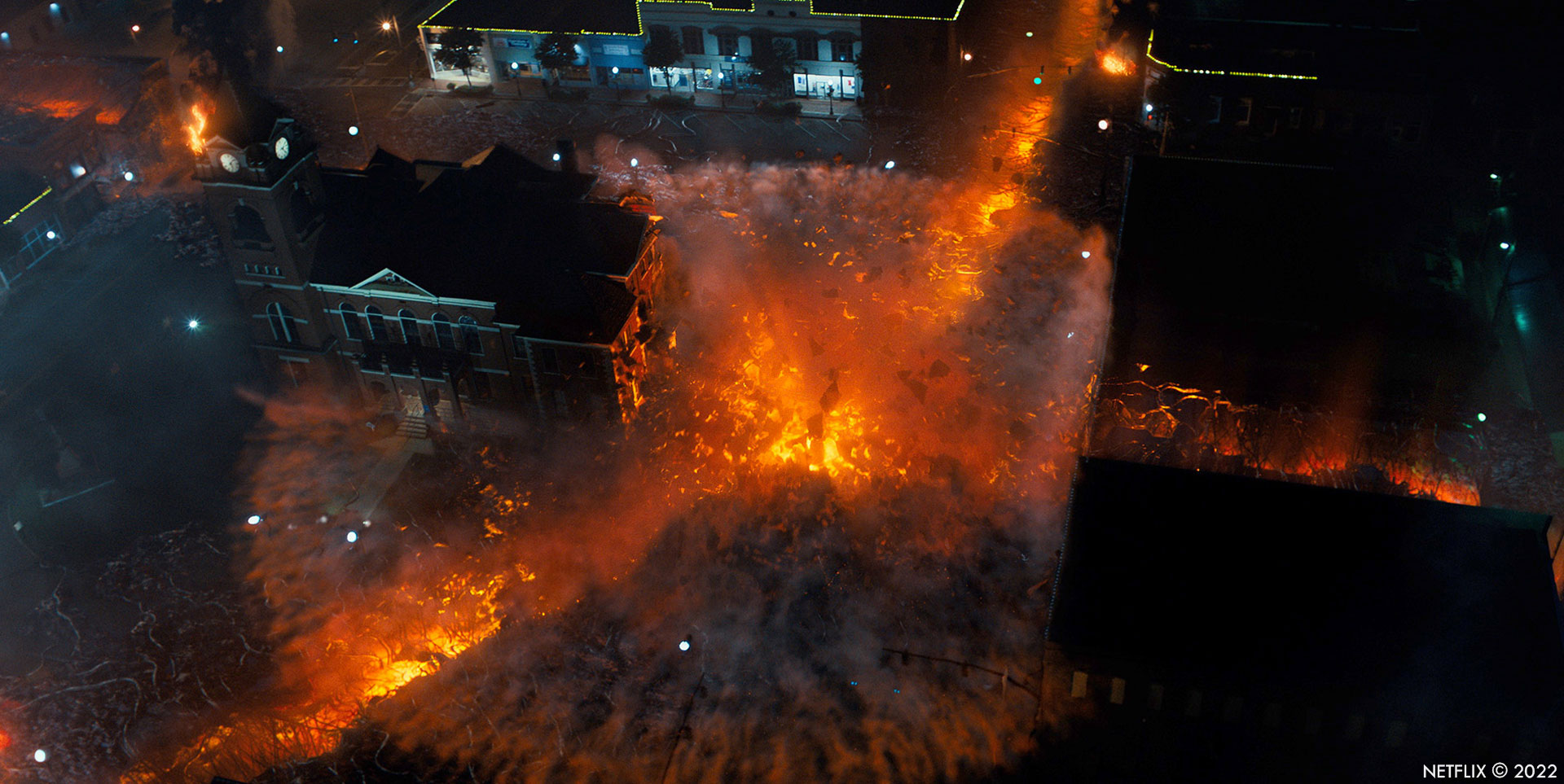
Can you explain in detail about the vehicle creation, especially the helicopter?
The practical helicopter was scanned on set then retopologized in Maya to create a 3D model. That model was then unwrapped and textures were painted in Mari and shaded in Substance Painter and V-Ray. Rigging and animation was done in Maya and FX in Houdini.
How did you create and animate the CG vines?
The sequence where the kids enter the Creel House in the Upside Down was shot on a set that had practical vines dressed on the wall but not on the floor or in the area where the kids get grabbed. The vines needed to look similar to the practical vines on set. The 3D vine models were relatively simple tubes and got most of their detail from texture and displacement. Those tubes were rigged with a series if IK/FK controls so they could be constrained to the match-moved digital kids or slither independently as needed. Blending them with the practical vines and selling that they were grabbing the kids required painstaking attention to reflections, shadows and matching of plate levels and colours.
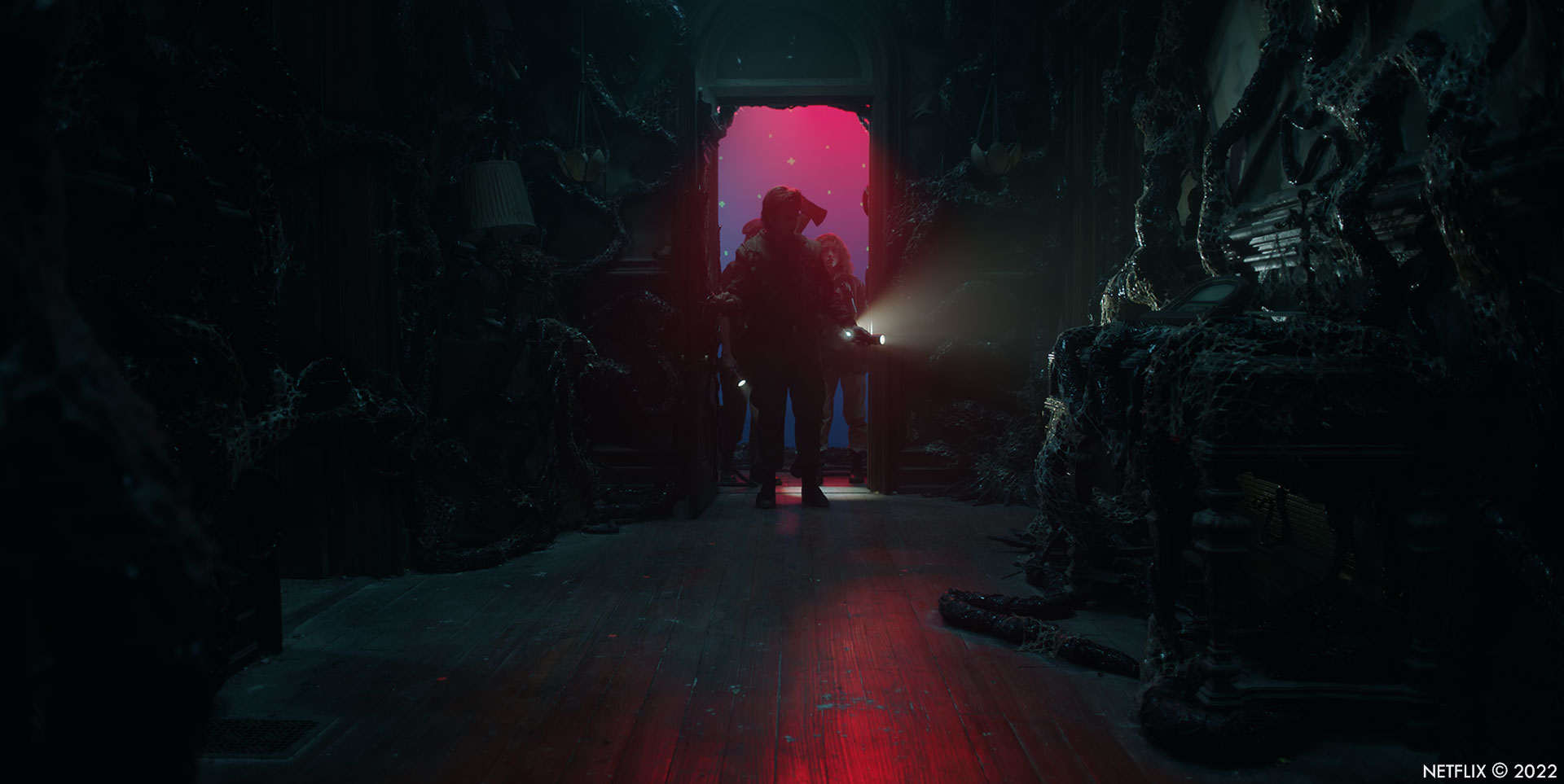
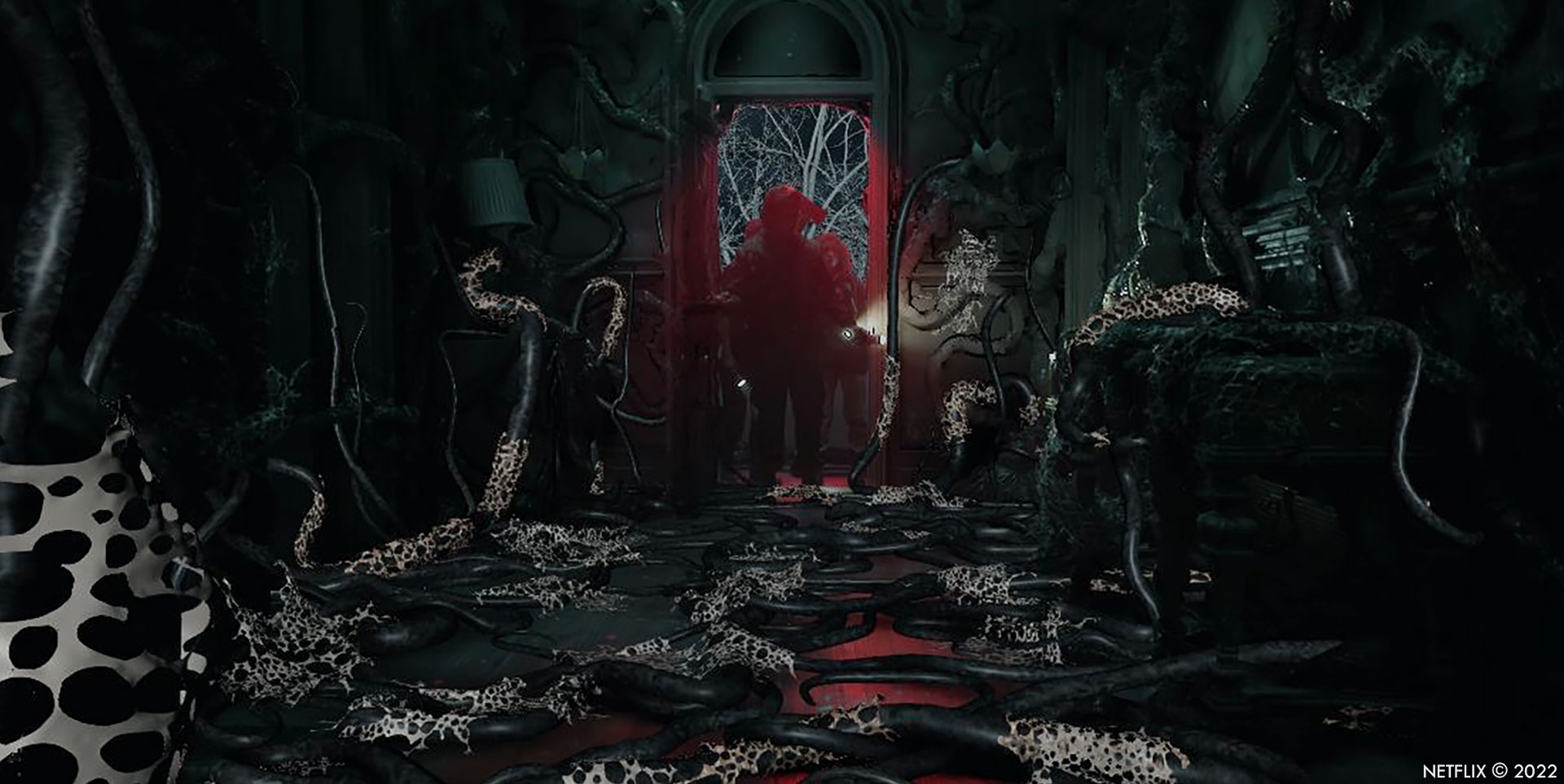
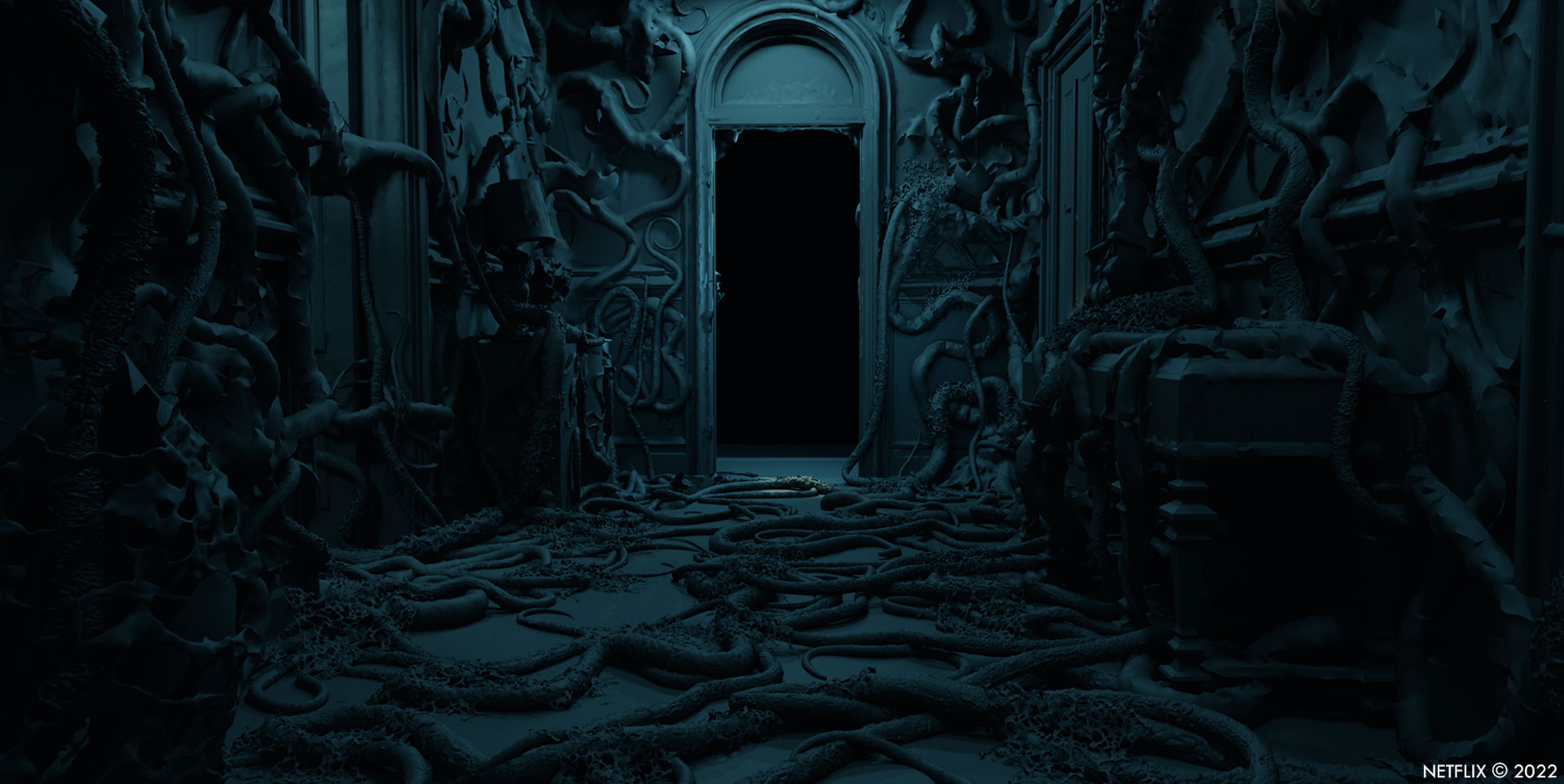
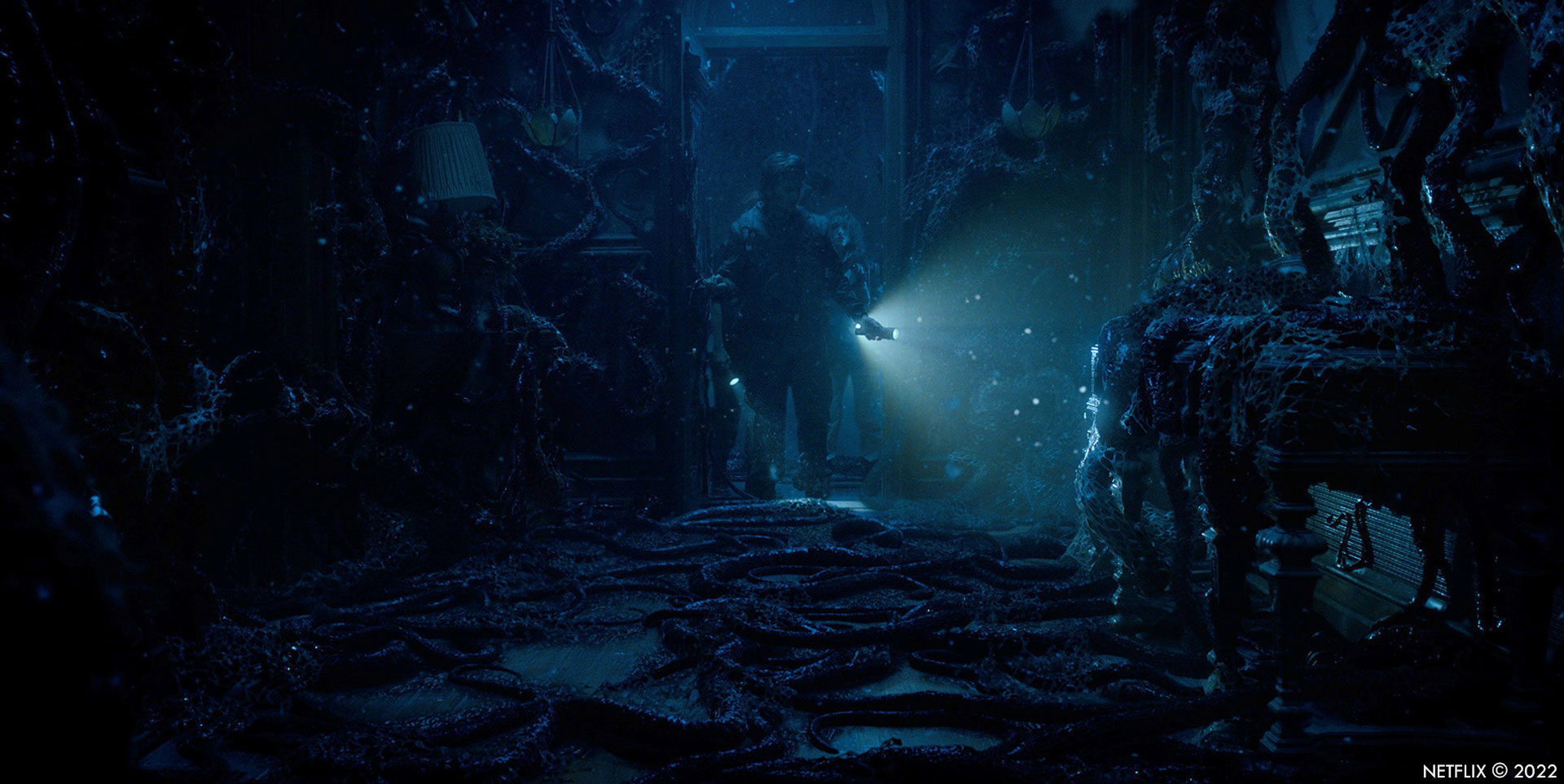
Which shot or sequence was the most challenging?
It was definitely the rifts converging on downtown Hawkins because of the complexity in those shots.
Was there something specific that gave you some really long nights?
We certainly worked some long nights and weekends right up to the release dates. It’s often surprising what shots become troublesome. Many times it’s not the big tentpole shots but rather something that seems simple but has unforeseen pitfalls like changing lighting or atmospherics in a plate that make integration tricky.
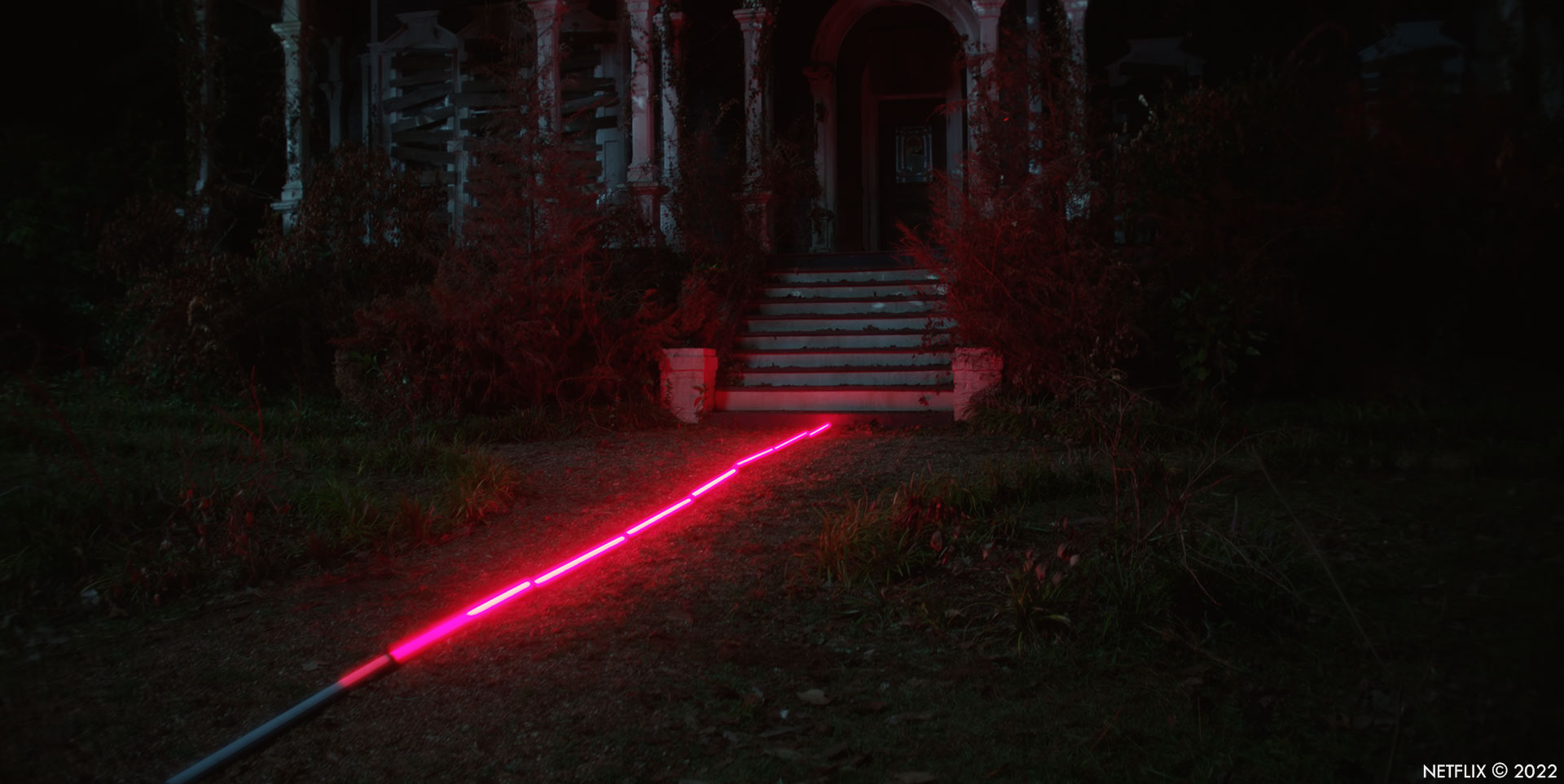
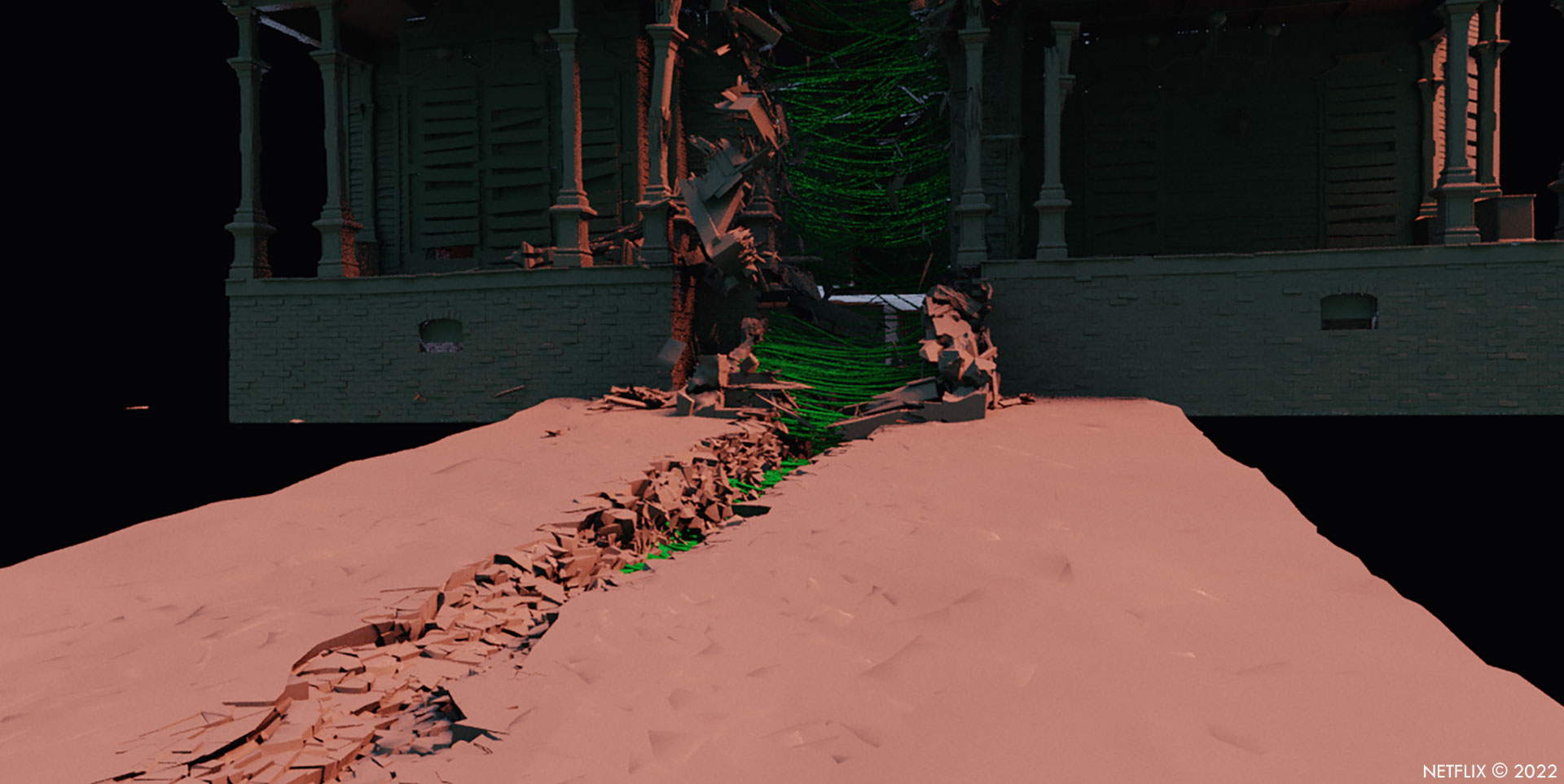
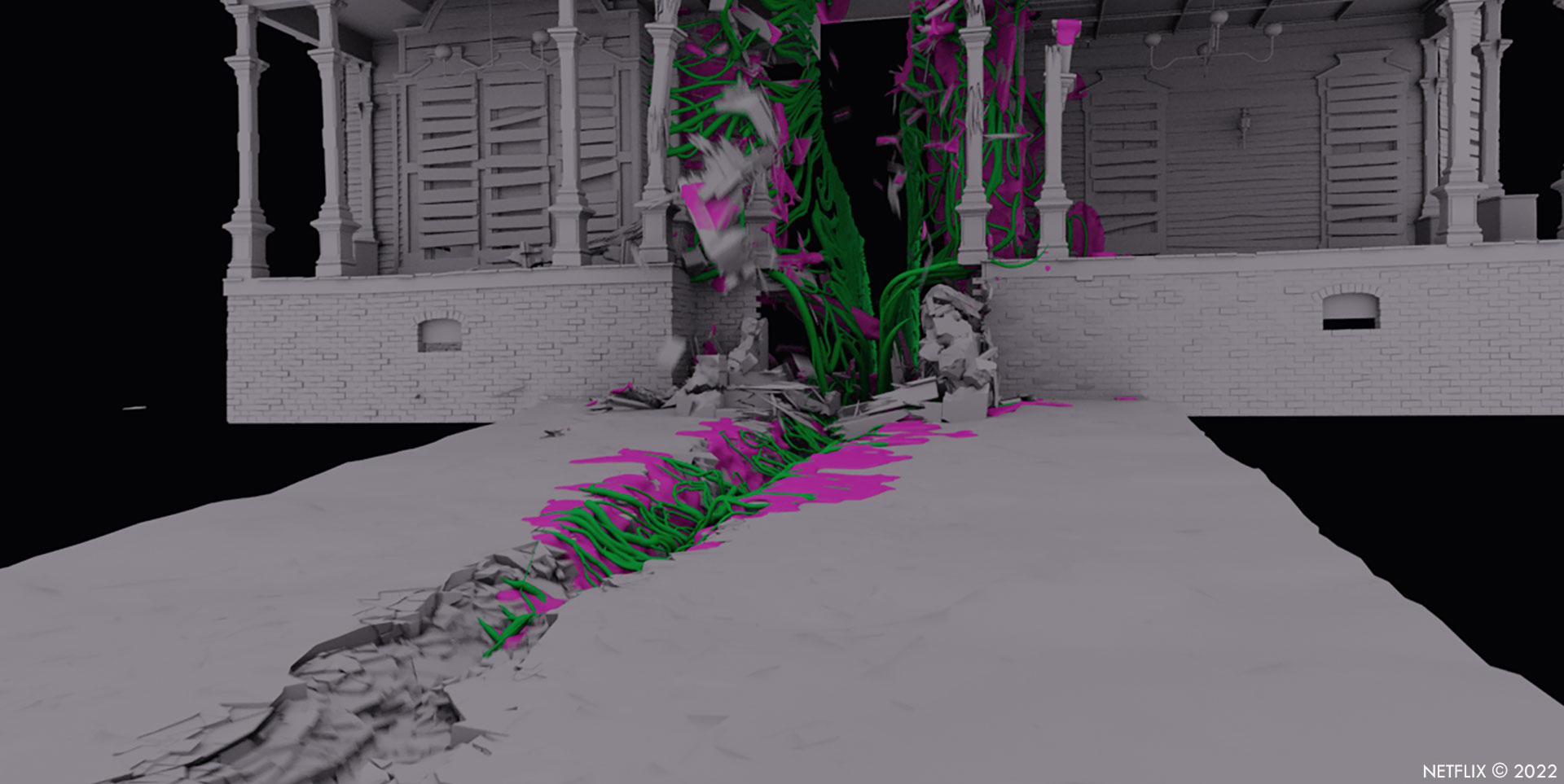
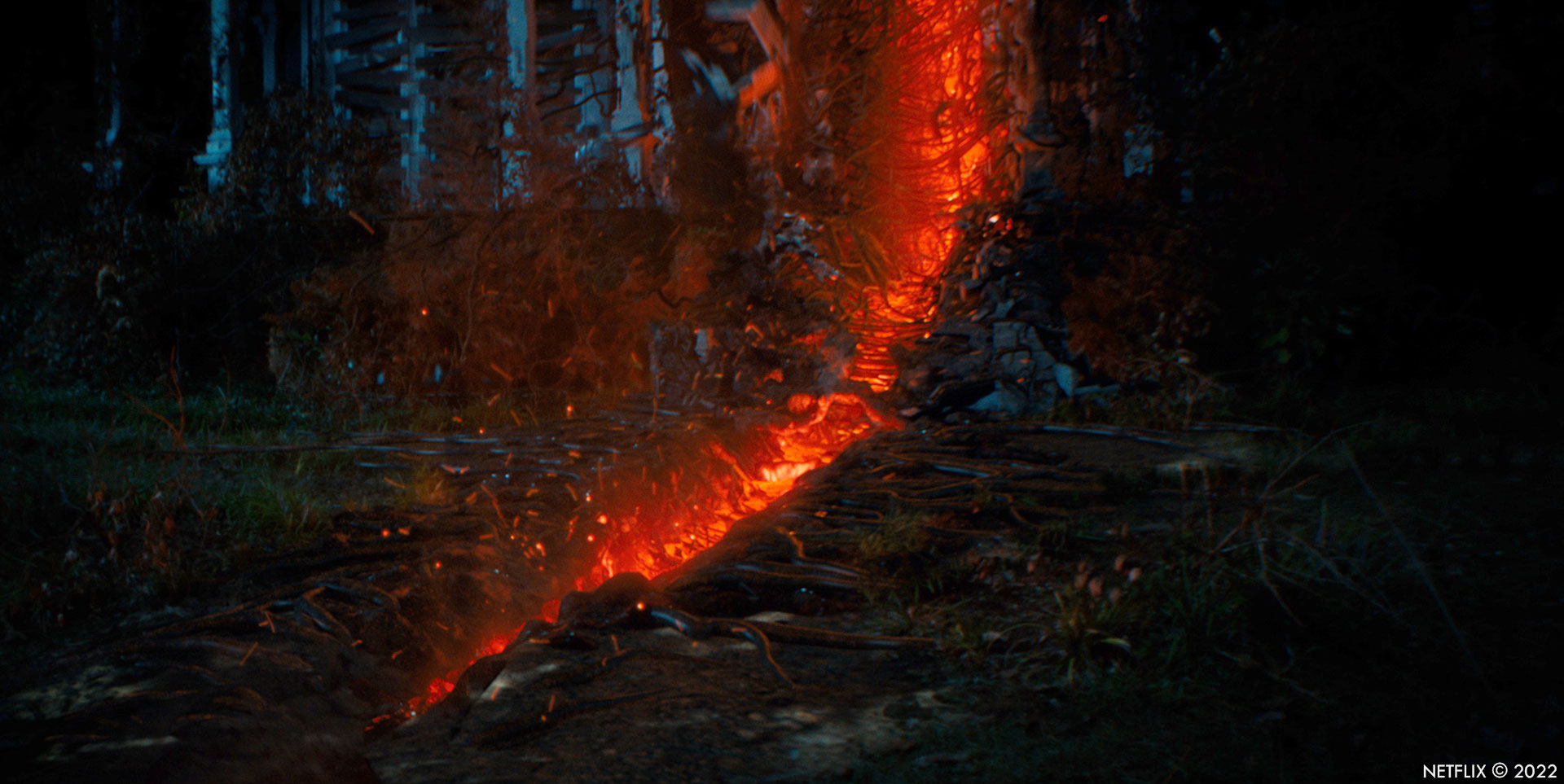
What is your favorite shot or sequence?
I really like the rift that forms after Eleven disintegrates One.
What is your best memory on this show?
Really it’s working with the team at Scanline.
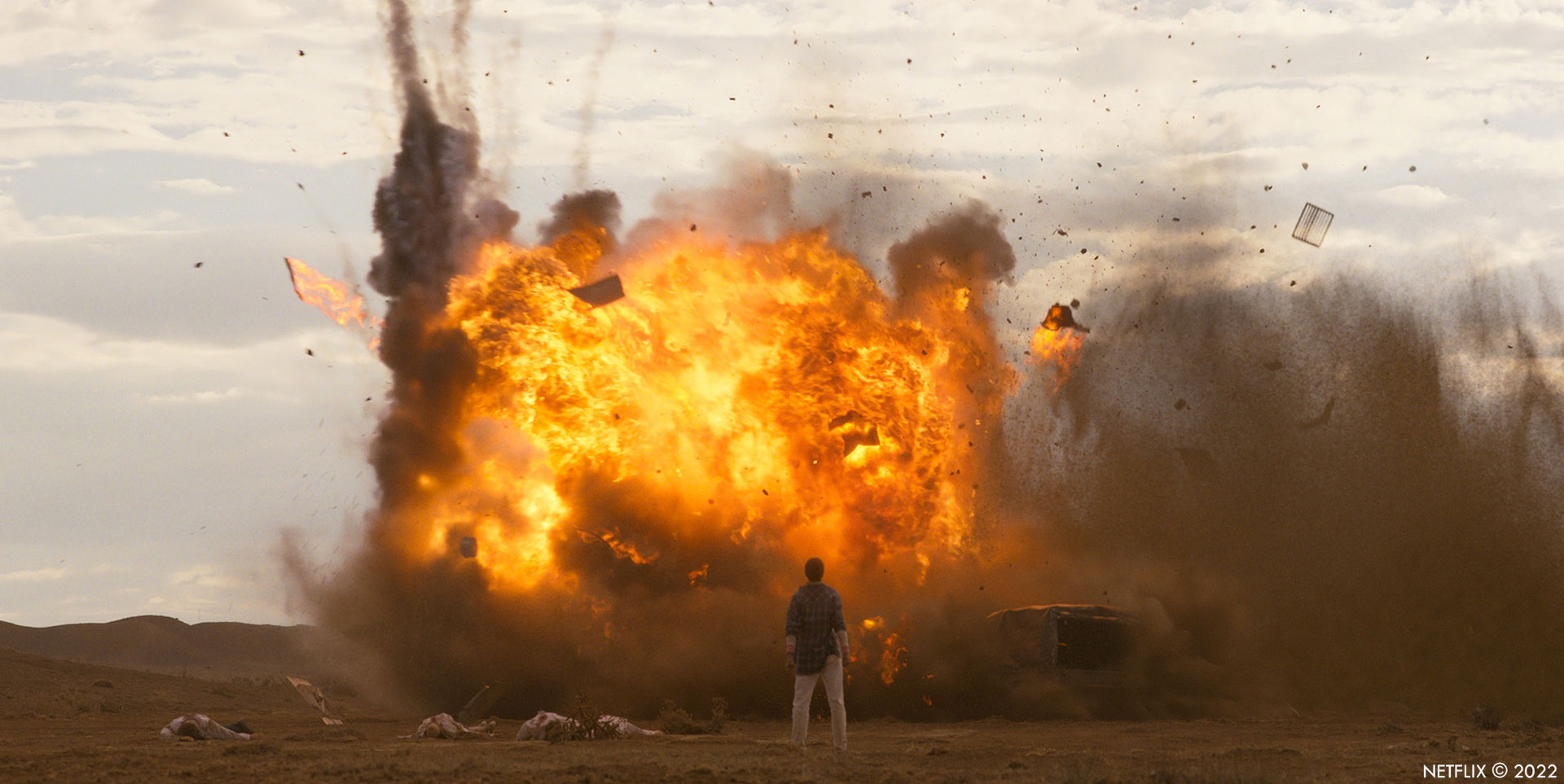
How long have you worked on this show?
About a year.
What’s the VFX shot count?
220 shots.
What was the size of your team?
around 200 people.
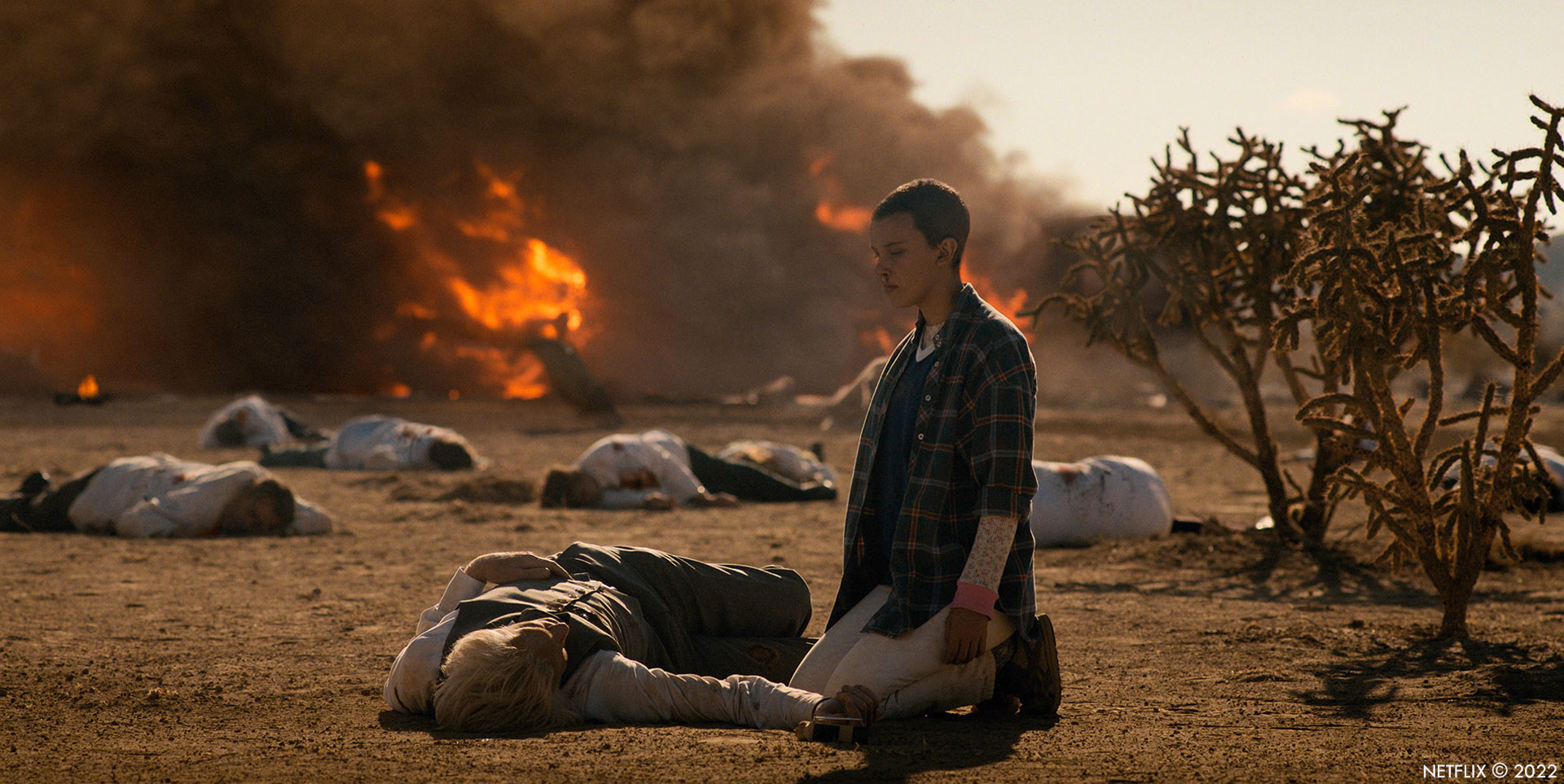
What is your next project?
I am not at liberty to say!
What are the four movies that gave you the passion for cinema?
Well for VFX: Star Wars, Blade Runner, Tron, The Terminator.
A big thanks for your time.
WANT TO KNOW MORE?
Michael Maher & Terron Pratt: Here is my interview with Michael Maher (Production VFX Supervisor) & Terron Pratt (Production VFX Producer) about Stranger Things – Season 4.
Netflix: You can stream Stranger Things on Netflix now.
© Vincent Frei – The Art of VFX – 2022






